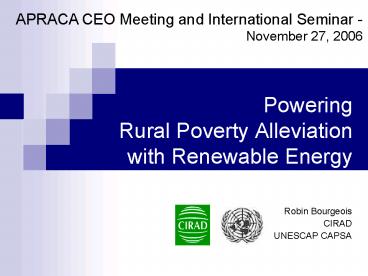Powering Rural Poverty Alleviation with Renewable Energy - PowerPoint PPT Presentation
1 / 14
Title:
Powering Rural Poverty Alleviation with Renewable Energy
Description:
landless people, smallholders, pastoralists, fishermen, tribes, ... No/limited biomass available from own resources (landless, small farmer) ... – PowerPoint PPT presentation
Number of Views:80
Avg rating:3.0/5.0
Title: Powering Rural Poverty Alleviation with Renewable Energy
1
Powering Rural Poverty Alleviationwith
Renewable Energy
APRACA CEO Meeting and International Seminar -
November 27, 2006
- Robin Bourgeois
- CIRAD
- UNESCAP CAPSA
2
- CONTENT
- Poverty in Asia
- Rural Poverty and Energy
- Pro-poor Renewable Energy
3
POVERTY IN ASIA
900 million of extremely poor people live and
work in rural areas
landless people, smallholders, pastoralists,
fishermen, tribes, female headed households,
displaced people
Source IFAD Report Rural Poverty Report 2001 -
The Challenge of Ending Rural Poverty
4
POVERTY IN ASIA
Most of the poor...
Source IFAD Report Rural Poverty Report 2001 -
The Challenge of Ending Rural Poverty
5
Poor Rural Households
RURAL POVERTY and ENERGY
- More than 5 people
- Limited land ownership (lt0,1) mostly dryland
limited livestock ownership - Limited assets and equipment house built from
non permanent material - Limited access to electricity and access to water
from manual tube well - Rudimentary cooking places and equipment
- Income dominated by wage labor (agricultural and
non-farm) - Dependence on natural resources and sensible to
external shocks - Up to 70 of the budget to food expenditure,
mainly rice and other staples
Photo R. Bourgeois and A. Nugraheni, Sumbawa and
Karangkobar, 2006
6
RURAL POVERTY and ENERGY
Some Facts
There is a correlation between energy
availability and poverty. Around 1.6 billion
people - living in the developing countries -
with no access to any type of commercial energy.
Up to 95 of energy generated by inefficient
burning of fuelwood, dung and plant wastes
expensive, insufficient to meet basic human needs
(nutrition, heat and lighting), nothing left over
for productive uses
Vast amount of time spent gathering something to
burn Pressures on the environment High pollution
levels in low-income dwellings Burden for
poverty-stricken women and children
Source World Energy Council. WEC News Energy
and Poverty, Article by Mr. Norberto de Franco
Medeiros.
7
RURAL POVERTY and ENERGY
Constraints
Cost distance, dispersion, accessibility Politica
l will no priority for rural poverty and
energy Short-term returns not likely Technology
not designed for the rural poor people Transfer
capacity to reach millions of people
8
RURAL POVERTY and ENERGY
Key Issues
For low-income rural communities, energy is a
crucial factor for getting out of poverty traps.
Actions providing poverty-prone rural areas with
access to energy are stepping-stones towards
progress by rural communities, while also easing
urban poverty
- Renewable energy is a priority in poverty-prone
area - Sources are available locally
- Transformation is possible locally
- Products can be used locally
- Multiplier effect on income, health, education,
infrastructure,
market, dignity
Source World Energy Council. WEC News Energy
and Poverty, Article by Mr. Norberto de Franco
Medeiros.
9
PRO-POOR RE
No Rural Development
Limited/No Local Growth
Poverty reduction
Renewable resources use
Economic Stagnation
Social Inequity
Pressure on Ecology
Energy Deprivation
Local Sourcesof renewable energy biomass, solar,
wind, micro hydro
The vicious circle
10
PRO-POOR RE
Sustainable Rural Development
Sustained Local Growth
Poverty reduction
Renewable resources use
Economic Opportunities
Socially equitable
Ecologically Sustainable
Local Energy Generation Use
Local Sourcesof renewable energy biomass, solar,
wind, micro hydro
The virtuous circle
11
PRO-POOR RE
Postulates
1. Energy Life
Humans first use energy to eat and work. For all
who have enough to eat, renewable energy is an
answer for environmental problems for the others
it is a matter of life. How can rural poor
populations benefit from opportunities generated
by progress in renewable energy research and
development?
2. Growth ? Development
Producing and exporting energy is not enough if
we dont want to let again rural areas behind and
miss the (RE) train. The question is not what
policy is needed to promote RE development but
What can we do for including rural pro-poor
development in energy policies?
3. Technology Instrument
Technologies for renewable energy generation fail
if they are not sensitive to rural
socio-political or economic constraints, or if
they have not taken into account gender or land
and resource tenure issues. The question is not
how much KWeq can we produce but How much can
technology improve the life of the rural poor
populations?
12
PRO-POOR RE
Strategic Elements
Effective RE contribution to poverty alleviation
13
Benefits expected from RE production Improve
health (conservation of medicaments and food,
food preparation/cooking) Generate jobs
(building/operating facilities, new possible
activities/business, time saved from gathering
sources of energy) Increase income
(new/additional jobs, value of unused
products) Induce self-reliance (from dirty
waste to clean energy, autonomy, time for
education, attractive living environment)
THE POOR
Other RE sources Under-utilised
STRATEGY Political commitment Promote local
biomass development and use before
expansion Quick impact with lasting
effects Include the poor in creation/operation
jobs Sharing of knowledge, knowhow, experience
Women, Landless, Very small farmers
Energy Crops Not Grown
Information
Land
Capital
Wastes Recycled
Isolated/Remote Poor Health Poor
Infrastructure Limited work opportunities
Residues Limited
Fuelwood Largely Used
POOR RURAL AREAS
Potential RE
Constraints to RE production by and for the rural
poor No/limited biomass available from own
resources (landless, small farmer) Cost of access
to poorest areas (transport, isolation) Availabili
ty of ready-to-use technologies (no focus of RD
on tech for the poor) Energy crops compete with
food crops for land, capital (priority to local
food security until food surplus is secured)
14
PRO-POOR RE
PRO-POOR RE
And the role of financing?
Effective RE contribution to poverty alleviation































